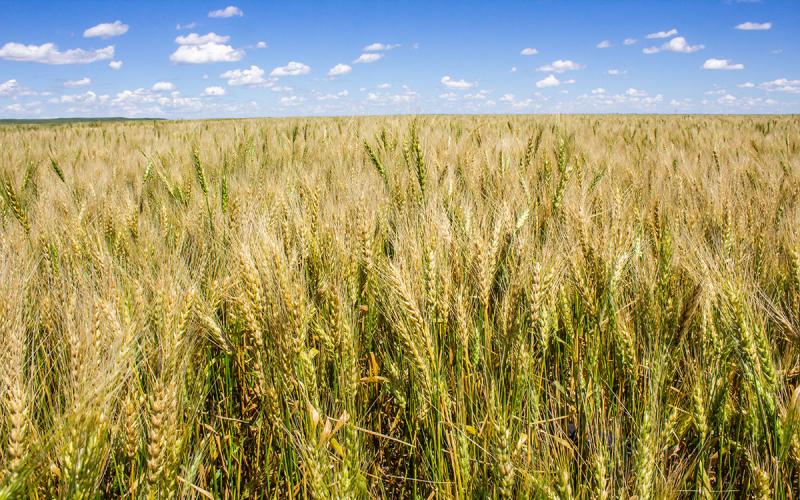Written with contributions by Emmanuel Byamukama, former SDSU Extension Plant Pathologist, Ruth Beck, Dalitso Yabwalo and Shaukat Ali.
Tan spot and powdery mildew pathogens are two residue-borne pathogens that can infect wheat early in the season. These diseases can lead to poor tillering, and their continued development can lead to yield loss. Some growers do apply a fungicide tank mixed with herbicide to save on the application costs at the tillering growth stage. However, does an early fungicide application alone result in a profitable yield?
Effects of Early Fungicide
Table 1 compares the effect of applying an early fungicide to a fungicide applied at flowering. A single fungicide application at tillering (Feekes 2) did not produce significantly different yield from the untreated plots. An early fungicide application followed by another fungicide application at flowering or a fungicide application at flowering alone resulted in increased yields by up to 12 bu/acre. These data and previous research from other universities indicate that an early fungicide alone may not always be profitable. Exceptions may include early development of stripe rust or where there is high early disease pressure resulting from when wheat is no-till planted into wheat residue.
| Fungicide/Timing | Yield (bu/A) | Test weight (lb/bu) | 1000-kernel weight |
|---|---|---|---|
| Untreated | 38.46 e | 52.35 d | 26.06 b |
| Headline 3fl oz/A @FK2 | 40.49 cde | 52.6 d | 27.04 a |
| Headline 3fl oz/A @FK2; | 49.64 abc | 55.24 c | 28.13 a |
| Prosaro 6.5fl oz/A @FK10.5.1 | 49.64 abc | 55.24 c | 28.13 a |
| Prosaro 6.5fl oz/A @FK10.5.1 | 49.42 abc | 55.44 c | 26.59 b |
| Prosaro 6.5fl oz/A @FK10.5.1# | 50.7 a | 55.93 c | 21.44 b |
Cultivar planted – Samson, FK2 = tillering growth stage, FK10.5.1 = flowering growth stage.
Scouting for Early Diseases
Scouting and determining the level of disease before a fungicide can be applied may improve the probability of obtaining a positive return on fungicide investment.

Tan Spot
- Tan spot can be found in almost every wheat field.
- Tan spot lesions appear first on the lower leaves and over time can be found in the mid canopy or throughout the canopy.
- Tan spot lesions have a dark brown center surrounded by a yellow halo (Figure 1).

Powdery Mildew
- Powdery mildew is more common in fields with early dense growth stemming from high soil fertility conditions.
- The disease develops in lower leaves where there is poor air movement and prolonged free moisture presence on the leaves.
- Initial symptoms of powdery mildew are small cotton mycelia on upper leaf surface and lower parts of the stem (Figure 2).
- Continued disease development can lead to an entire leaf surface covered with ash-like powdery mildew pathogen mycelia and this disease level can lead to tiller abortion and reduced grain yield.
Early Fungal Disease Management
Growers should scout their fields before deciding to apply a fungicide early in the season to determine the type and level of diseases developing in their fields. If tan spot and powdery mildew are just starting, a fungicide may be delayed as these diseases do not typically spread as quickly. However, for fields planted into wheat stubble and with moderate levels of fungal leaf spots developing, a fungicide applied at herbicide timing may be beneficial. An additional fungicide, however, may be needed at flowering to protect the flag leaf and the leaf below flag leaf as well as protect against Fusarium head blight. Use the Mesonet at SDState’s Small Grains Disease Prediction Tool to keep track of weather conditions conducive for leaf spot diseases to develop in wheat for later growth stages (be sure to select the growth stage and the weather station nearest your area). Crop rotation that includes a broad-leaf crop such as sunflower, soybean, field peas and others can help reduce inoculum of residue-borne pathogens.
Additional Resources
- Friskop et al 2018. Low benefits from fungicide use on hard red wheat in low disease environments. Plant Health Progress 18 #4.
- Weisz et al 2011. Multiple mid-Atlantic field experiments show no economic benefit to fungicide application when fungal disease is absent in winter wheat. Phytopathology. 2011;101:323–333. doi: 10.1094/PHYTO-03-10-0096.


